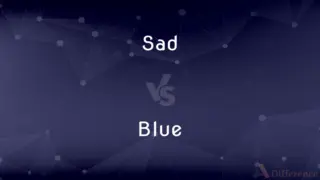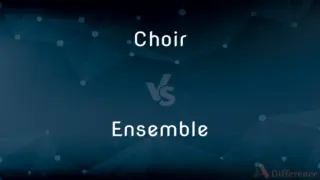Elf vs. Sprite — What's the Difference?
By Maham Liaqat & Fiza Rafique — Updated on April 8, 2024
Elves are mythical beings often depicted with magical powers and a close association with nature, while sprites are spirit-like entities, typically linked to elements such as water or air.
Difference Between Elf and Sprite
Table of Contents
ADVERTISEMENT
Key Differences
Elves are often depicted as wise, ancient beings that are taller than humans and live in forests or other natural settings, embodying the magic and mystery of nature. On the other hand, sprites are considered ethereal and less physically defined, often portrayed as smaller, playful, and mischievous.
While elves are celebrated for their profound connection with nature, emphasizing their role as protectors of forests and wildlife, sprites represent the whimsical and unpredictable aspects of nature. Sprites, unlike their elfish counterparts, are often visualized as fleeting and less tangible, embodying the less tangible aspects of the natural world, such as the wind, water flow, or the flickering of fire.
Elves, in many cultures, are associated with the moral and ethical aspects of the natural world, often serving as a bridge between the human and supernatural realms. They are sometimes seen as guardians of ancient wisdom and traditions, holding deep respect for the balance of nature. Conversely, sprites are less concerned with moralities or the broader balance of nature and more with the immediate aspects of their natural domain, focusing on the joy, mischief, or caprice found within their element.
In terms of cultural significance, elves have played a central role in many mythologies and fantasy stories, symbolizing the deeper, often hidden forces of nature and the complexity of human-nature relationships. Sprites, while also significant, usually occupy a lighter, more whimsical space in folklore, embodying the playful, sometimes benignly mischievous aspects of the natural world they represent.
Both elves and sprites are integral to the mythologies and folklore in which they appear, their roles, appearances, and the essence of their being vary significantly. Elves, with their majestic and often solemn nature, contrast with the lighter, more capricious spirits of the sprites, highlighting the diverse ways humans have imagined the unseen forces of nature.
ADVERTISEMENT
Comparison Chart
Nature
Mythical being, often nature-bound.
Spirit-like entity, tied to elements.
Appearance
Taller, pointed ears, ethereal beauty.
Smaller, less defined, elementally linked.
Characteristics
Wise, ancient, connected to nature.
Playful, mischievous, elemental.
Cultural Role
Protectors, wisdom keepers.
Whimsical, elemental forces.
Connection to Nature
Deep, guardians of forests.
Immediate, embodying natural forces.
Compare with Definitions
Elf
Wisdom and Longevity.
Due to their long lifespan, elves are considered wise and knowledgeable about ancient lore.
Sprite
Less Tangible.
Unlike elves, sprites are less physically defined, appearing as fleeting and ethereal beings.
Elf
Aloof and Superior.
Elves sometimes view themselves as superior to humans and other races, maintaining a distance.
Sprite
Playful Guardians.
While not as solemn as elves, sprites still play a role in protecting their natural domains, albeit in a more whimsical manner.
Elf
Skilled Craftsmen.
Elves are known for their exceptional crafting skills, creating artifacts of great beauty and power.
Sprite
Mischievous Nature.
Sprites are known for their playful and sometimes mischievous behavior, often playing tricks on humans.
Elf
Protector of Nature.
Elves are often portrayed as guardians of the natural world, safeguarding its secrets and balance.
Sprite
Elemental Spirit.
A sprite is a spirit-like entity, often associated with water or air, and embodies the whimsical aspects of nature.
Elf
Mythical Being.
In folklore, an elf is a mythical being that embodies the magic and mystery of the forests.
Sprite
Elementally Linked.
Sprites are closely tied to specific elements, such as streams, forests, and the breeze.
Elf
An elf (plural: elves) is a type of humanoid supernatural being in Germanic mythology and folklore (especially North Germanic mythology and folklore). In medieval Germanic-speaking cultures, elves generally seem to have been thought of as beings with magical powers and supernatural beauty, ambivalent towards everyday people and capable of either helping or hindering them.
Sprite
A small or elusive supernatural being; an elf or pixie.
Elf
A mythical creature in human form but usually smaller, often considered mischievous.
Sprite
An elflike person.
Elf
A lively, mischievous child.
Sprite
(Meteorology) A large, dim, red flash that appears above active thunderstorms in conjunction with lightning.
Elf
A usually sprightly or mischievous or sometimes spiteful person.
Sprite
(Archaic) A spirit, specter, or ghost.
Elf
(Norse mythology) A luminous spirit presiding over nature and fertility and dwelling in the world of Álfheim (Elfland). Compare angel, nymph, fairy.
Sprite
(mythology) A spirit; a soul; a shade.
Elf
Any from a race of mythical, supernatural beings resembling but seen as distinct from human beings. They are usually delicate-featured and skilled in magic or spellcrafting; sometimes depicted as clashing with dwarves, especially in modern fantasy literature.
Sprite
An apparition; ghost
Elf
(fantasy) Any of the magical, typically forest-guarding races bearing some similarities to the Norse álfar (through Tolkien's Eldar).
Sprite
(mythology) An elf; a fairy; a goblin.
Elf
A very diminutive person; a dwarf.
Sprite
(computer graphics) A two-dimensional image or animation that is integrated into a larger scene.
Elf
(South Africa) The bluefish (Pomatomus saltatrix).
Sprite
An electrical discharge that occurs high above the cumulonimbus cloud of an active thunderstorm.
Elf
To twist into elflocks (of hair); to mat.
Sprite
The green woodpecker, or yaffle (Picus viridis).
Elf
An imaginary supernatural being, commonly a little sprite, much like a fairy; a mythological diminutive spirit, supposed to haunt hills and wild places, and generally represented as delighting in mischievous tricks.
Every elf, and fairy sprite,Hop as light as bird from brier.
Sprite
(entomology) Any of various African damselflies of the genus Pseudagrion (of which, Australian species are named riverdamsels).
Elf
A very diminutive person; a dwarf.
Sprite
A spayed female ferret.
Elf
To entangle mischievously, as an elf might do.
Elf all my hair in knots.
Sprite
(obsolete) frame of mind, disposition
Elf
(folklore) fairies that are somewhat mischievous
Sprite
A spirit; a soul; a shade; also, an apparition. See Spright.
Gaping graves received the wandering, guilty sprite.
Elf
Below 3 kilohertz
Sprite
An elf; a fairy; a goblin.
Sprite
The green woodpecker, or yaffle.
Sprite
Small, human in form, playful, having magical powers
Common Curiosities
What is an elf?
An elf is a mythical being often depicted with magical powers and a close association with nature.
What kind of powers do elves have?
Elves are known for their wisdom, crafting skills, and sometimes magical abilities that allow them to protect nature.
Are sprites considered good or evil?
Sprites are usually considered neutral, embodying the playful and mischievous aspects of nature without a clear alignment toward good or evil.
Can elves and sprites coexist in the same mythology?
Yes, elves and sprites often coexist in various mythologies, each playing distinct roles within the natural and supernatural world.
How do elves and sprites differ in appearance?
Elves are often depicted as taller beings with pointed ears and ethereal beauty, while sprites are smaller, playful, and less physically defined.
What role do elves play in folklore?
In folklore, elves are often seen as protectors of the forest and guardians of ancient wisdom and traditions.
What role do sprites play in folklore?
Sprites play a more whimsical, sometimes mischievous role in folklore, often associated with specific natural elements or phenomena.
What is a sprite?
A sprite is a spirit-like entity, typically linked to elements such as water or air.
Are there different types of elves?
Yes, there are various types of elves depicted in different cultures and fantasy literature, each with unique traits and roles.
Do elves age?
Elves are often depicted as aging very slowly or being virtually immortal, with lifespans that far exceed those of humans.
Can sprites be seen by humans?
Sprites, being more ethereal and fleeting, are often invisible to humans unless they choose to reveal themselves.
What is the cultural significance of elves and sprites?
Both elves and sprites hold significant cultural roles, symbolizing various aspects of the natural world and human interaction with it, with elves often representing wisdom and protection, and sprites embodying the playful forces of nature.
Are there different types of sprites?
Yes, sprites can vary based on the natural element they are associated with, such as water sprites, fire sprites, or air sprites.
How do sprites interact with the natural world?
Sprites interact with the natural world by embodying and influencing the elements they are associated with, such as causing a breeze or a ripple in water.
How do elves communicate with humans?
Elves can communicate with humans through speech, telepathy, or other magical means, depending on the mythology.
Share Your Discovery

Previous Comparison
Sad vs. Blue
Next Comparison
Choir vs. EnsembleAuthor Spotlight
Written by
Maham LiaqatCo-written by
Fiza RafiqueFiza Rafique is a skilled content writer at AskDifference.com, where she meticulously refines and enhances written pieces. Drawing from her vast editorial expertise, Fiza ensures clarity, accuracy, and precision in every article. Passionate about language, she continually seeks to elevate the quality of content for readers worldwide.














































